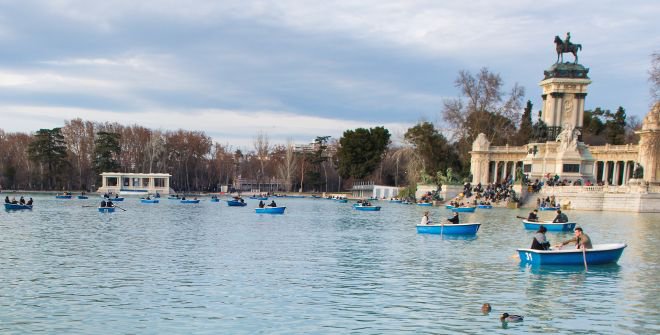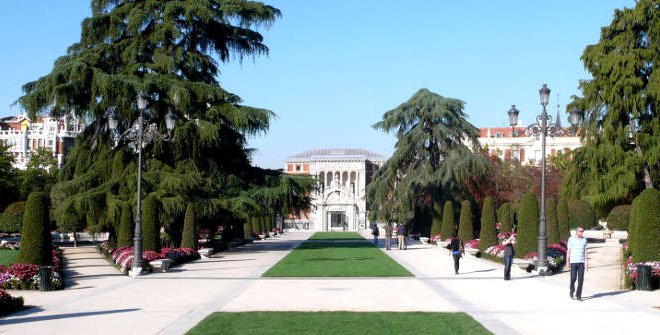PLEASE NOTE: El Retiro and eight of the city’s other parks (El Capricho, Sabatini Gardens, the Rose Garden in Oeste Park, Juan Carlos I, Juan Pablo II, Quinta de Fuente del Berro, Quinta de los Molinos and Quinta Torre Arias) may close if weather conditions are severe. On these occasions you are also advised not to visit Dehesa de la Villa and Oeste Park which have no gates and cannot be closed to the public.
Covering over 125 hectares and comprising more than 15,000 trees, El Retiro Park–recently named a UNESCO World Heritage Site–is a green oasis in the heart of the city. In it you’ll find all kinds of interesting monuments and gardens, including Jardín de Vivaces, Jardines de Cecilio Rodríguez (Andalusian-inspired classicistic gardens), Jardines del Arquitecto Herrero Palacios, the recently-restored Cat Mountain , the Rosaleda rose garden and Parterre Francés, which holds a Mexican conifer that is nearly 400 years old and is believed to be Madrid’s oldest tree.
In addition to its role as one of the city’s green lungs, it is also a popular spot among Madrileños who like to go there for a stroll, to do some sport, visit an exhibition or take the kids to a puppet show. The park is home to a large artificial lake Velázquez Palace Glass Palace Reina Sofía Museum
El Retiro is also filled with interesting sculptures and fountains such as the magnificent Monument to Alfonso XII Fallen Angel Galápagos Fountain Teatro de Títeres Reservado de Fernando VII which King Ferdinand VII decided to keep for himself and his family when the rest of the park was opened to the public. In this section of El Retiro, between Calle O’Donnell and Calle Menéndez Pelayo, you’ll find some of the king's "whims", small buildings or monuments designed as little retreats for the monarchs to rest and relax: Casa del Pescador , the recently reopend Cat Mountain and Casa del Contrabandista , which now houses Florida Park
Since autumn 2023, visitors to El Retiro Park can also explore the fully restored Monkey Pit , which is part of what used to be the Retiro Menagerie, the precursor to Madrid Zoo
A wonderful green space where you can relax... or work out
A firm favourite with both locals and tourists, El Retiro is a great place to go rollerblading, for a long walk or a jog. Dotted with playgrounds of different sizes, it’s just as popular with the little ones.
As you explore El Retiro, you could also visit the Municipal Sports Centre La Chopera , the Eugenio Trías Public Library , the Casa de Vacas Cultural Centre or the recently renovated area surrounding the Meteorological Observatory (one of the historic sites within the Park, which has a private area, the Castillo del Telégrafo gardens, and a pool known as El Baño de la Elefanta, where elephants once bathed).
And if you are passionate about botany, be sure to visit the ahuehuete or Montezuma cypress , perhaps one of the oldest trees in Madrid. It is said to have stood on this spot since 1630 and it is a very exotic species that does not lose all its leaves every year, just a few of them. Apparently, during the War of Independence against the French, it was one of the few specimens that were saved in the Park, which was taken over by the French as their headquarters. Apparently
, Napoleon’s soldiers decided to set up a huge cannon between the branches of the enormous tree and fired them from there.
However, the oldest tree in El Retiro is currently a 627-year-old olive tree dating from approximately 1396, planted in one of the meadows near the Gate of the Fallen Angel.
If you fancy pedaling around the park, you can rent a bicycle
Every year the park plays host to popular events such as the Book Fair San Isidro ,
A UNESCO World Heritage Site
On 25 July 2021, El Retiro Park and the Paseo del Prado were declared a UNESCO World Heritage Site . In this extraordinary site that boasts “outstanding universal value”, culture, science and nature have coalesced since the mid 16th century. The area is home to such landmarks as the Prado, Thyssen-Bornemisza and Reina Sofía museums, Cibeles Palace – the current seat of Madrid City Council– , Puerta de Alcalá gate and the Botanical Gardens.
 ruta_6_retiro.jpg
ruta_6_retiro.jpg parquedeelretiroparejaalvarodeoro.jpg
parquedeelretiroparejaalvarodeoro.jpg retiro_0173.jpg
retiro_0173.jpg retiro3_1402494288.043.jpg
retiro3_1402494288.043.jpg ParquedeElRetiroCason_1432205660.177.jpg
ParquedeElRetiroCason_1432205660.177.jpg parquedeelretiromonumentoalfonsoalvarodeoro.jpg
parquedeelretiromonumentoalfonsoalvarodeoro.jpg retiro4_1402494276.422.jpg
retiro4_1402494276.422.jpg ParquedelRetiro_1432204684.3.jpg
ParquedelRetiro_1432204684.3.jpg The 22 screeens installed next to the accesses to El Retiro show you at all times a map of the park and your current location.
The 22 screeens installed next to the accesses to El Retiro show you at all times a map of the park and your current location.























